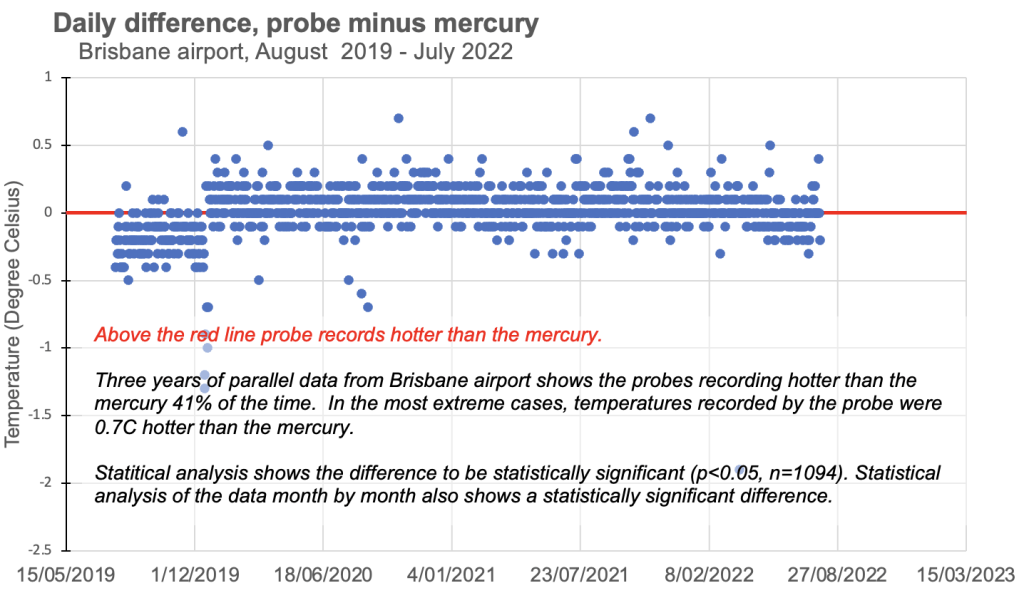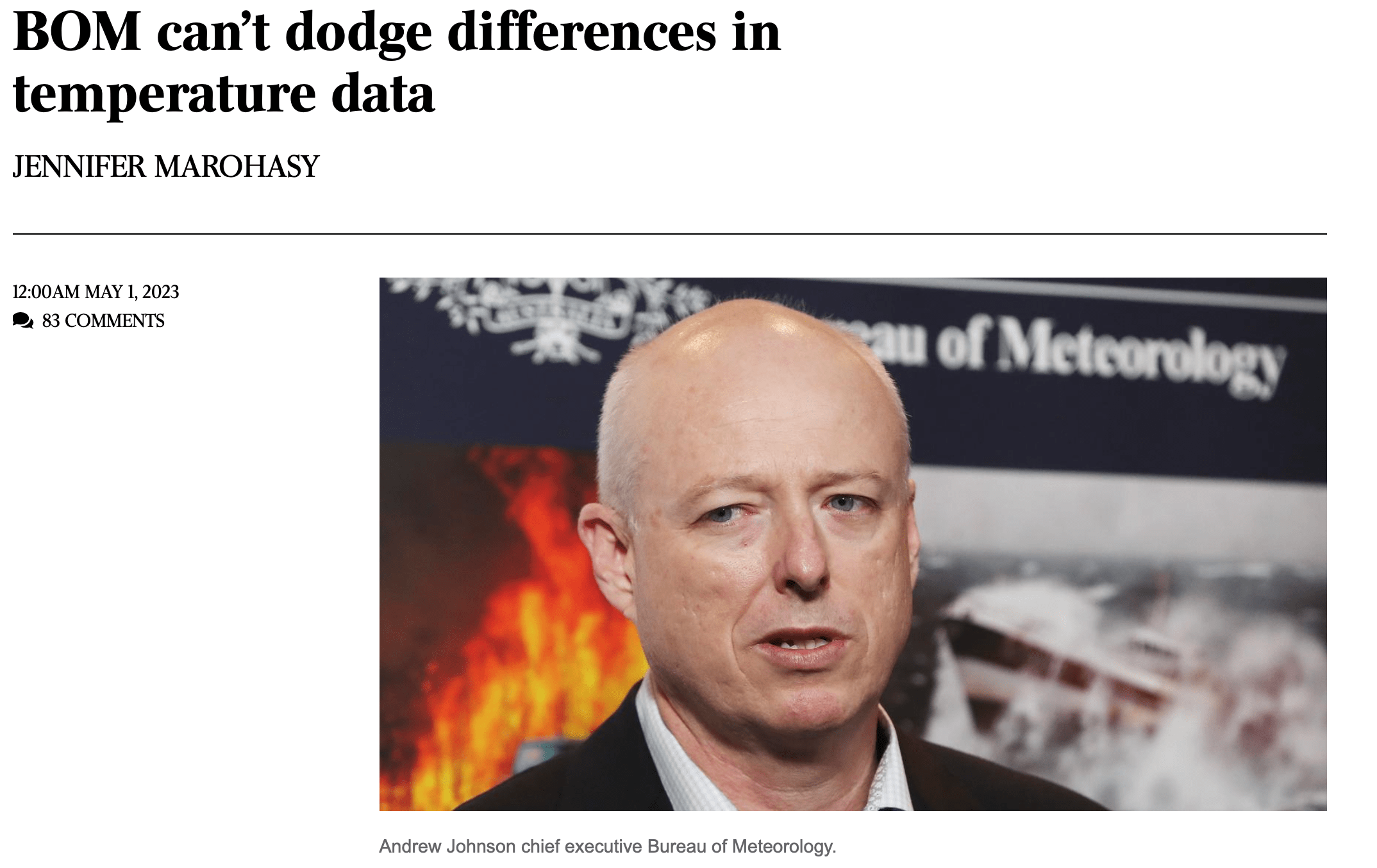Since Graham Lloyd’s article ‘Mercury Rising in BOM probe row’ was published on the front page of The Weekend Australian earlier this month, there has been some confusion regarding the availability of the parallel temperature data.
These are the temperatures handwritten into the Field Books of Meteorological Observations, both the temperatures as recorded by a mercury thermometer, and from the platinum resistance probes, at the same place and on the same day.
I spent the first of several minutes of a prerecorded interview with Michael Condon from ABC NSW Country Hour earlier this month arguing with him about this. He was repeating wrong information from the Bureau of Meteorology’s Chief Customer Officer, Peter Stone.
Specifically, Condon incorrectly claimed that the bureau makes all its temperature data publicly available on its website, including the parallel data. This claim, that is apparently being repeated across university campuses, flatly contradicts the opening paragraphs of Lloyd’s article. Lloyd correctly explained that it was only after a Freedom of Information request and three years of arguing with the Bureau (including over the very existence of these Field Books/A8 reports and whether their release was in the public interest), and then the case eventually going to the Administrative Appeals Tribunal on February 3, that some of the parallel data for Brisbane Airport was released.
So begins an article on page 13 of today’s The Australian, with the same article available online, click here ($ subscription required).
As Lloyd reported early this month, only three years of the 15 years of data for Brisbane airport was released to John Abbot on the Thursday before Easter and this is just a fraction of the 760 years of parallel data the bureau holds for 38 different locations spread across the landmass of Australia.
I’ve had several academics phone and email me over the last few days asking for assistance in locating the parallel data for Brisbane Airport online. I have explained that this was never provided to me in an electronic form, but as over a thousand handwritten pages. I manually transcribed the handwritten entries over Easter and undertook preliminary analysis of this data.
My analysis of the three years of parallel temperature data from Brisbane Airport shows that 41% of the time the probe is recording hotter than the mercury, and 26% of the time cooler. The difference is statistically significant (paired t Test, n = 1094, p < 0.05). The differences are not randomly distributed, and there is a distinct discontinuity after December 2019.
I initially thought that this step-change from an average monthly difference of minus 0.28C in December 2019 to plus 0.11 in January 2020 (a difference of 0.39C) represented recalibration of the probe.
The bureau has denied this, explaining there was a fault in the automatic weather station that was immediately fixed and operating within specifications from January 2020 onwards. Yet even after January 2020, the probe was recording up to 0.7C warmer than the mercury thermometer at Brisbane Airport.

The bureau does not dispute my findings. It has not provided its own analysis of the data beyond claiming that its own assessment of the full 2019-2022 period finds ‘no significant difference between the probe and mercury thermometer’.
I understood this to mean that the Bureau finds no statistically significant difference, but two academics, without seeing or analysing this data, have separately indicated to me that: The Bureau are just correctly saying that the differences are small. They are making no statistical claims. These same academics, having read Lloyd’s article in the Weekend Australian, know that the difference between measurements from the probe and mercury can be up to 1.9C – this is how much the mercury recorded warmer than the probe on one occasion. More usually the probe recorded warmer than the mercury. Yet they insist, and I quote: The Bureau’s rebuttal makes no claim of statistical testing. They are just saying that differences are within tolerance.
It seems that some Australian academics are on the one hand, quite prepared to claim that we should be fearful of temperatures exceeding a 1.5C tipping point, yet at the same be unconcerned about the accuracy or otherwise of measurements from official bureau weather stations.
The question for me continues to be whether the probes that have replaced mercury thermometers at most of the Bureaus’ 700 official weather stations, are recording the same temperatures that would have been recorded using a mercury thermometer.
In his letter to the editor of The Australian on April 19, the bureau’s chief executive, Andrew Johnson, explains that they follow all the World Meteorological Organisation rules when it comes to measuring temperatures. This is as absurd as the bureau’s Peter Stone claiming that all the parallel data is online.
The Bureau is unique in the world in taking instantaneous readings from the probes and using the highest in any 24-hour period as the maximum temperature for that day.
In the US, one-second samples are numerically averaged over five minutes, with the highest average over a five minute period recorded as the daily maximum temperature.
This is to achieve some equivalence with traditional mercury thermometers that have a slower response time, more inertia.
In contrast here in Australia, the bureau, use the highest instantaneous spot readings as the maximum temperature for that day. So, depending on how the probe is calibrated, it can generate new record hot days for the same weather.

I am very grateful that this article is published in The Australian.
I am also grateful that Ross Cameron from TNTRadio has indicated he will follow this saga, and has interviewed me the last two Sunday’s with the show available as a podcast, click here.
You can listen to a fair edit (about 10 minutes of the 50 minute conversation) of my prerecorded interview with Michael Condon on the ABC Country Hour by clicking here. I begin at about 11 minutes.



 Jennifer Marohasy BSc PhD is a critical thinker with expertise in the scientific method.
Jennifer Marohasy BSc PhD is a critical thinker with expertise in the scientific method.

Sorry to say but the interview with Michael Condon is not available at the link given – the message says ‘Sorry, this audio is not yet available or has expired’.
No wonder someone like who has 2 University degrees no longer trusts the scientific authorities. Keep up the good work Jennifer.
Note Jennifer;
The current Minor Dry Cycle has now concluded (May 1, 2023) from 10 degrees West, (Portugal). Note also, the Minor and Regional Dry Cycles, now begin to the West of Australia, for a number of years following. The Dry Cycles migrate from East to West, at 15 degrees Longitude per 30 Day/Night Interval Month,(see Chronology in ‘Tomorrow’ Weather’ 30 Years on….
Remember, the temperatures rise under a Dry Cycle influence – due to less moisture Albedo, unless ameliorated by Volcanic activity.
https://drive.google.com/file/d/1TFFDXyhe5b0ZfLCiFt23W4PbubQaQfQo/view?usp=sharing
>”They are just saying that differences are within tolerance.” [quote from academics as Jennifer listed, above]
Are these people, or the BoM, prepared to detail the actual limits of this “tolerance” ?
What stirs this topic up for the activists is any wider-spread publicity it may get. Refusing to supply the data, denying it exists, crab walking around “tolerance”, are all aspects of fear … fear that claims of apocalyptic climate disaster now almost upon us sinners may be sussed out as highly exaggerated by increasing numbers of the general populace.
Better to run the Climategate tactic; nothing to see here, it’s all misquoted, never really happened, too trivial to consider. And anyway, the MSM will bury it for them. Well, the ABC tried to of course, but the Aus refused to a large degree.
Great developing story, Jennifer.